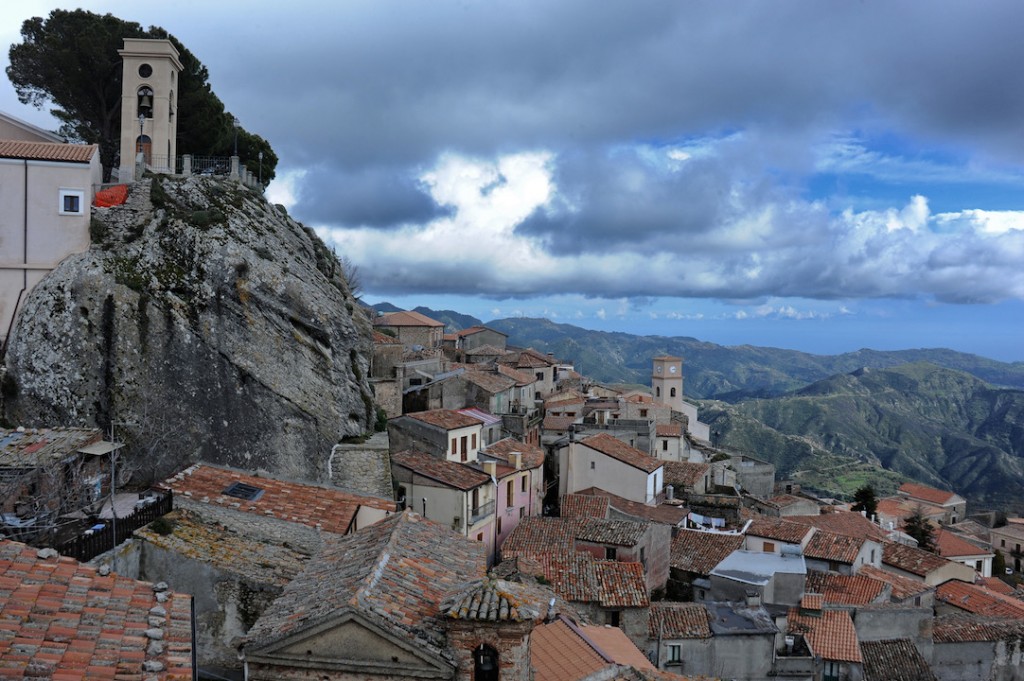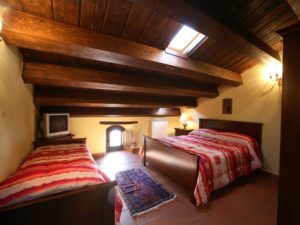Vuà B&B
Disponibilita Camere
Camere
General Info
The B&B is situated in Bova (960 metres above sea level) the town considered the capital of the Magna Grecia area and the principal gateway to the Parco Nazionale d’Aspromonte [The Aspromonte National Park]. We provide nature-lovers many first-rate opportunities to go trekking and take excursions -with shuttle service- where they can avail of the professionalism of the official guides of the National Park of Aspromonte who will accompany them along the paths up to Montalto, one of the area’s tallest peaks, 1,956 meters above sea level.
The B&B occupies an old house that has been completely renovated, has three storeys and an attic … while providing an extremely panoramic view, on fine days, of Mount Etna …
The rooms are comfortable and bright, equipped with every comfort, including heating, TV …
Furthermore, we have reached standing agreements with restaurants in the area to guarantee full board. One really special thing about this B&B is its location, only 10 minutes from the Reggio-Calabrian Ionian coastline, ideal for a holiday between the seaside and the mountains.
Check-in
Check-out
Servizi
 Conditioned Air
Conditioned Air Internet
Internet Parking
Parking Restaurant
Restaurant Televisione
Televisione
Bova

The Capital of Greek Calabria and one of Italy’s most beautiful historic centres, the origins of Bova go far back in history. The foundation of Bova is attributed to the legendary Greek queen, Oichista, who is said to have left her footprint on the highest point of the fortress that towers over the town.
The remote origins of the city of Bova (Vua) have been confirmed by several archaeological finds from the Neolithic period, brought to light in the vicinity of the Norman Castle, while historical documentary evidence, testifying to the existence of Bova, goes back to the beginning of the second millennium AD, when, between 1040 and 1064, the Normans ousted the Arabs and Byzantines from power in Sicily and Calabria.
THE NAME
In Greek it is called Boos, in the local dialect Vua. It may be a Latinised form of the Greek boua (flock) from bous (ox). Some hold that the name comes from the Mediaeval Greek boua, meaning a trench full of grain.
HAMLETS AND TOWNLANDS
Brigha, Polemo, Caloghiero, Cavalli, Vunemo.
HISTORY
Bova is the Greek-speaking heart of the region and it is not surprising that the term Bovesìa indicates the entire Graecanic Area.
Inhabited continuously from Neolithic times, the Bova’s Rocca was probably a Magna-Graecian fortress on the borders of the poleis of Reggio and Locri. At the end of the sixth century AD, thanks to its strategic position, the site seems to have been chosen as a refuge by inhabitants fleeing from the coast when barbarian hordes, probably Lombards, burned the Roman statio of Scyle, situated, most likely, in the present-day San Pasquale area of Bova Marina. It is highly probable that Bova, like many other historical centres of southern Calabria, was fortified against Saracen raids, to become a diocesan headquarters, as early as the tenth century. Conquered by the Normans, it became the fiefdom of Guglielmo when the bishopric was held by Luke (1095 -1140), proclaimed a saint after he acted as mediator between the Latin Church and the Greek faithful for the entire southern area of Reggio. In 1162, the diocese was donated as a fiefdom to the Archbishop of Reggio and remained such until 1806. The diocesan headquarters of Bova kept the Greek-Byzantine liturgical rite alive until 1572, when, adhering to the Tridentine rules, the Armenian Bishop, Julius Stavriano, suppressed it. Bova was one of the last Italian dioceses to be Latinised by the Roman Catholic Church, whose power was consolidated in Calabria as late as the seventeenth century, the period to which most of the architectural heritage of Bova belongs. Although the capital of Graecanic Calabria has maintained its medieval urban layout, the town has been enriched by late-Baroque buildings and monumental, eighteenth-century palaces. Of particular note are the façades of the churches of San Leo, erected in 1606, San Rocco and Spirito Santo built, respectively, in 1622 and 1631. Worthy of note are the side-aisle portal of the Isodia co-Cathedral, dating from the end of the seventeenth century and the delicate façades of the Chiesa del Carmine and the Church of the Immacolata both built in the eighteenth century. In most of the town’s places of worship it is possible to admire precious late sixteenth-century sculptures, like the Isodia Madonna by Rinaldo Bonanno (1584), the Madonna and Child (1590), attributed to the Bonanno school and now in the church of Santa Caterina, as well as the statue of San Leo (1582), the authorship of which is uncertain and which may be admired in the homonymous sanctuary.
ILLUSTRIOUS PERSONAGES
In modern times, Bova has given birth to Bruno Casile, whom Pier Paolo Pasolini defined “the peasant poet”, and to Agostino Siviglia, another great Graecanic poet.
EXPLORING THE HISTORIC CENTRE
The Chòra [City] stands at 820 metres above sea level.
Upon arriving in Bova, visitors become awestruck. In a clearing facing the main square, stands one of the symbols of emigration, a 740 Ansaldo-Breda locomotive from 1911, the Italian State Railway Company’s most emblematic steam engine. Then their gaze falls on the imposing Palazzo dei Nesci Sant’Agata, with its crenelated arch, erected in 1822. Overlooking the main square stands the Town Hall, built at the beginning of the twentieth century on the foundations of Palazzo Marzano, of which only the neighbouring family chapel, dedicated to the Immaculate Conception, remains to house the town’s present-day tourist information office. Behind it stands the Sanctuary of San Leo, the town’s patron saint, Saint Leo, an Italo-Greek monk who lived during the twelfth century in the vicinity of Africo Vecchio. His mortal remains are preserved in a silver urn commissioned in 1855, in Naples, by Antonino Marzano. The casket, in silver, is surmounted by a beautiful silver bust portraying the saint, the work of a Messinese silversmith in 1635. On the altar, consecrated in 1755, stands a marble statue of Saint Leo, holding an axe and a ball of pitch, iconographical references to his work as a picaro (resin harvester) something he undertook to earn the means to practice charity. Sculpted in 1582, it is considered the masterpiece of Rinaldo Bonanno, though some do not exclude the hypothesis that Gian Lorenzo Bernini’s father, Pietro, may have had a hand in it. According to others, it is by Michelangelo Naccherino, a Florentine artist who worked in the Kingdom of Naples during the second half of the sixteenth century. Behind the church stands the Gateway to the Aspromonte National Park, where one can visit an original exhibition providing a suggestive summary of the Graecanic cultural tradition. One thousand steps lead up to the fortress that towers over the town at an altitude of 950 metres above sea level. This Ancient fortress, which dates from Byzantine times, was rebuilt in both Norman and Angevin times, the epoch to which the few remaining remnants of the outer walls belong. At the foot of the fortress stands the Cathedral of the Isodia, a Byzantine title indicating the Virgin Mary on the occasion of her presentation in the Temple by her mother Saint Anne. In 1572, in this church the Cypriot bishop, Giulio Stavriano, abolished the Byzantine rite, thus proclaiming the completion of the Latinisation of the southernmost area of the Italian peninsula. Following the outline of the rock faces surrounding Bova one catches a glimpse of the last of the towers which, from Angevin times (thirteenth-fourteenth centuries), encircle the city. The quarter known as Pirgoli, (in Greek “towers”) was once Bova’s giudecca. Its southern gateway was incorporated into the arch uniting the two wings of the Mesiano Mazzacuva Palace, rebuilt after the earthquake of 1783. The church of San Rocco, built at the ancient entrance to the town at the end of the plague epidemic of 1577 is also worth visiting. The building was probably completed in 1622, the year in which, according to an inscription on the building, the main portal was built. The church houses a nineteenth-century wooden statue of San Rocco.
The town is also home to two important museums: the Museo della Lingua Grecanica [Museum of the Calabrian-Greek language] dedicated to Gerhard Rohlfs, a well-known German linguist who informed the entire world of the ancient origins of this language and the Museo Civico di Paleontologia e Scienze Naturali dell’Aspromonte [The Civic Museum of Palaeontology and Natural Sciences of the Aspromonte], both situated at the entrance to the city. In the ancient Rao zone, near the Mucicipal Square stands the Museo all’aperto della Civiltà Contadina [The Open-air Museum of Peasant Civilisation] inaugurated recently thanks to the endeavours of Saverio Micheletta, a Bovese emigrant who sought to immortalise memories of his childhood by exhibiting objects from the everyday agro-pastoral life of his homeland.
TRADITIONS AND HANDICRAFTS
Bova is one of the few villages which continue many of the ancient customs and traditions.
Here the local crafts have profound, remote roots, of which weaving is one of the finest. Weavers traditionally used a handloom to turn the natural materials, wool, linen, cotton and broom, into fabric, which, with three panels sewn together, formed the famous vutane blanket or bedspread. The most common patterns, dating back to the Byzantine era are the “mattunarico“, the “telizio“, the “greco“, and the “muddare“.
The other historic craft typical of this place is woodcarving. Originally, finely whittled wooden objects were produced by the local shepherds: frames, cake pans (plumia), spoons (mistre) and especially the musulupare, moulds for the traditional Aspromontese “musulupu” cheese.
FOOD
The local cuisine provides tastes and colours that are deliciously and exclusively Mediterranean, though its origin is undeniably Graecanic. Characterised by products of the agro-pastoral tradition, the cuisine here is based on goat’s milk, tomatoes, olive oil, the ingredients of delicacies like maccarruni cu sucu di crap [macaroni with goat’s-meat ragout] cordeddi [strips of homemade pasta] in tomato sauce, tagghiarini [finely cut homemade tagliatella-type pasta] with chickpeas, the ricchi di previti [priests’ ears] with tomato, capra alla vutana [stewed goat’s meat, garnished with herbs and vegetables]. Highly sought after here are cured meats [sausage, capocollo (rolled neck), brawn], cheeses, including ricotta and musulupi [a fresh cheese eaten at Easte]) and confectionary, like Christmastide pretali , the traditional Eastertime ‘nghute, the scaddateddi, doughnuts with caraway seeds. It is a must to taste lestopitta [literally quick bread] , a pancake made of flour and water, fried in oil and eaten hot.
https://youtu.be/nlbNZE9TxU8
Continua a leggere














